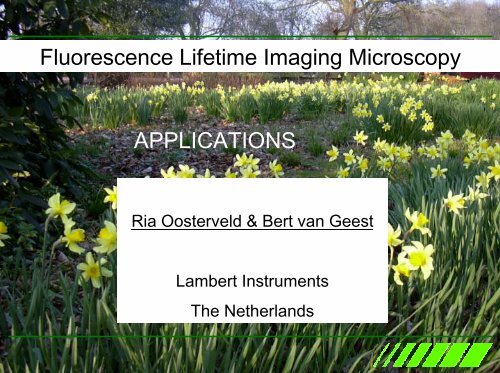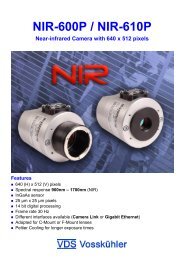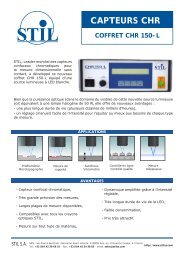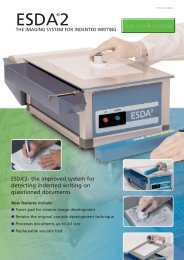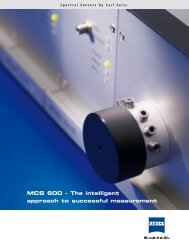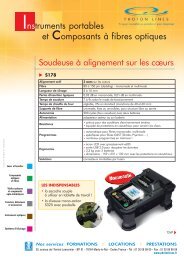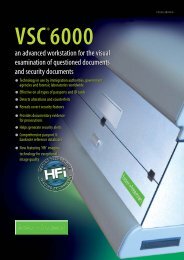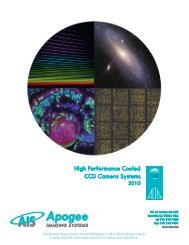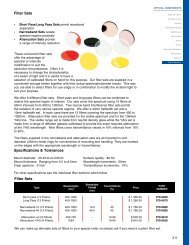Fluorescence Lifetime Imaging Microscopy ... - Photon Lines
Fluorescence Lifetime Imaging Microscopy ... - Photon Lines
Fluorescence Lifetime Imaging Microscopy ... - Photon Lines
You also want an ePaper? Increase the reach of your titles
YUMPU automatically turns print PDFs into web optimized ePapers that Google loves.
<strong>Fluorescence</strong> <strong>Lifetime</strong> <strong>Imaging</strong> <strong>Microscopy</strong><br />
APPLICATIONS<br />
Ria Oosterveld & Bert van Geest<br />
Lambert Instruments<br />
The Netherlands
<strong>Fluorescence</strong> <strong>Lifetime</strong><br />
<strong>Fluorescence</strong> lifetime =<br />
average time that molecules stay<br />
in their excited state<br />
E 1<br />
Excitation<br />
Emission<br />
some nanoseconds<br />
E 0
<strong>Fluorescence</strong> <strong>Lifetime</strong><br />
Intensity<br />
1/e<br />
I<br />
= I 0 e<br />
−<br />
τ t<br />
τ<br />
Time (ns)<br />
Excitation<br />
Emission<br />
Exponential decay curve<br />
Time constant τ (tau)<br />
“<strong>Fluorescence</strong> <strong>Lifetime</strong>”
FLIM = <strong>Fluorescence</strong> <strong>Lifetime</strong> <strong>Imaging</strong> <strong>Microscopy</strong><br />
28,000 counts<br />
Intensity<br />
<strong>Lifetime</strong><br />
2,6ns<br />
Merge<br />
2,1ns<br />
Cell<br />
transfected<br />
with pCFP<br />
10,000 counts<br />
1,6ns<br />
Images taken with the LIFA system: FLIM at the widefield fluorescence microscope<br />
• Spatial distribution + lifetime in one image<br />
• Independent of intensity variations inside cells<br />
(bleaching / concentration variations)
FLIM = <strong>Fluorescence</strong> <strong>Lifetime</strong> <strong>Imaging</strong> <strong>Microscopy</strong><br />
Intensity <strong>Lifetime</strong> Merge<br />
35,000 counts<br />
1,6ns<br />
5,000 counts<br />
0,4ns<br />
Images taken with the LIFA system: FLIM at the widefield fluorescence microscope<br />
20,000 counts<br />
1,8ns<br />
Skin of<br />
human head<br />
4,000 counts<br />
• Discrimination different dyes<br />
(similar absorption/ emission, different lifetime)<br />
• Living cells and fixed materials<br />
0,2ns<br />
Convolaria
FLIM = <strong>Fluorescence</strong> <strong>Lifetime</strong> <strong>Imaging</strong> <strong>Microscopy</strong><br />
• Applications various:<br />
(Some phenomena do affect fluorescence lifetimes)<br />
ion imaging<br />
oxygen imaging<br />
probing microenvironment<br />
medical diagnosis<br />
FRET<br />
Most used application<br />
nowadays
FRET = Förster Resonance Energy Transfer<br />
Application: detection of interactions like protein-protein,<br />
lipid-protein,<br />
DNA-protein,<br />
as well as conformational changes inside proteins.<br />
D<br />
x<br />
Ay<br />
A<br />
D<br />
x A y<br />
A<br />
E.g. Proteins x and y,<br />
tagged/ labelled with<br />
donor fluorophore D and acceptor fluorophore A
FRET<br />
FRET only occurs if…<br />
• the donor fluorescence emission spectrum overlaps<br />
with the acceptor absorbance<br />
• the donor and acceptor fluorophores are in close<br />
proximity (1 - 9 nm)<br />
• the transition dipole moments of the donor and acceptor<br />
fluorophores are not perpendicular.
donor<br />
FRET detection by FLIM<br />
donor<br />
acceptor<br />
(τ D )<br />
E 1<br />
E 0<br />
donor<br />
lifetime τ D<br />
decrease<br />
upon FRET<br />
(τ FRET )<br />
E 1<br />
E 1<br />
E 0<br />
E 0<br />
D<br />
x<br />
Ay<br />
D<br />
x Ay<br />
A<br />
A
donor<br />
FRET detection by FLIM<br />
donor<br />
acceptor<br />
E 1<br />
(τ D )<br />
E 0<br />
(τ FRET )<br />
E 1<br />
E 1<br />
E 0<br />
E 0<br />
<strong>Lifetime</strong> of donor (τ D ) has to be measured only !!<br />
FRET efficiency =<br />
τ D - τ FRET<br />
τ D
30,000 counts<br />
5,000 counts<br />
Intensity<br />
FRET detection by FLIM<br />
<strong>Lifetime</strong><br />
2,9ns<br />
2,7ns<br />
2,3ns<br />
1,0ns<br />
Merge<br />
FRET at<br />
centrosomes<br />
(2,3ns<br />
versus<br />
2,7ns)<br />
NO FRET at<br />
centrosomes<br />
(all 2,7ns)<br />
Images taken with the LIFA system: FLIM at the widefield fluorescence microscope<br />
FRET efficiency =<br />
τ D - τ FRET<br />
2,7 - 2,3<br />
=<br />
= 14,8%<br />
τ D<br />
2,7<br />
courtesy of Prof. Diaspro (Genua, Italy)
Example: FRET-FLIM (LIFA)<br />
Living cells transiently transfected with pCFP and with pCFP-YFP<br />
2,4ns<br />
1,9ns<br />
Intensity<br />
(YFP band pass cube)<br />
Intensity<br />
(CFP band pass cube)<br />
<strong>Lifetime</strong><br />
(CFP band pass cube)<br />
Images taken with the LIFA system: FLIM at the widefield fluorescence microscope<br />
courtesy of J. Hageman (Groningen, The Netherlands)
Example: FRET-FLIM (LIFA)<br />
Venus-<br />
EGFR +<br />
anti-P-CY3<br />
<strong>Lifetime</strong> 2,1 ns<br />
<strong>Lifetime</strong> 1,7 ns<br />
P of EGF receptor<br />
Images taken with the LIFA system: FLIM at the widefield fluorescence microscope<br />
courtesy of Dr. T. Nagai (Sapporo, Japan)
Analysis: LI FLIM software program<br />
Fit-on-point<br />
• per pixel shown (here: x 322, y 226)<br />
Integrated<br />
Intensity<br />
Detector phase (0 - 360)
Analysis: LI FLIM software program<br />
Histogram<br />
• in one view which lifetimes are present in ROI<br />
# pixels<br />
<strong>Lifetime</strong> (ns)
Analysis: LI FLIM software program<br />
Statistics<br />
• per ROI mean lifetime[phase] + st.dev.<br />
• mean lifetime[mod] + st.dev.<br />
• # pixels<br />
• minimum and maximum lifetime
LI FLIM software program - Time series<br />
Time series<br />
• per ROI dynamics of lifetime in time<br />
• automatic scaling<br />
E.g. FRET<br />
<strong>Lifetime</strong> (ns)<br />
Elapsed time (s)
LI FLIM software program - Time series<br />
2,2<br />
2,2ns<br />
<strong>Lifetime</strong> (ns)<br />
2<br />
1,8<br />
1,6<br />
0 20 40 60 80 100 120 140<br />
scale bar<br />
1,6ns<br />
Intensity (adu)<br />
30000<br />
25000<br />
20000<br />
15000<br />
10000<br />
5000<br />
0<br />
0 20 40 60 80 100 120 140<br />
Forskolin<br />
Elapsed time (min)<br />
<strong>Lifetime</strong> + Intensity<br />
of brain tissue<br />
movie<br />
courtesy of Dr. P. Vincent (Paris, France)
LI FLIM software program - Time series<br />
lifetime (ns)<br />
3,30<br />
3,25<br />
3,20<br />
3,15<br />
3,10<br />
3,05<br />
3,00<br />
EGF<br />
FRET eff. = 6,5%<br />
3,5ns<br />
scale bar<br />
lifetime<br />
2,95<br />
2,90<br />
0<br />
120<br />
<strong>Lifetime</strong> +<br />
Intensity<br />
of living<br />
cells<br />
movies<br />
240<br />
360<br />
480<br />
600<br />
intensity<br />
720<br />
840<br />
960<br />
1080<br />
1200<br />
2,5ns<br />
lifetime + intensity<br />
courtesy of Dr. P. Bastiaens (Argentina 08-2006)
LI FLIM software program - Time series<br />
Real time FLIM<br />
movie<br />
12 lifetime images per second
Intensity<br />
20,000 counts<br />
LI FLIM software program - Time series<br />
2,000 counts<br />
<strong>Lifetime</strong><br />
4,6ns<br />
4,4ns<br />
4,0ns<br />
3,6ns<br />
0’ 4’ 6’ 9’ 11’ 14’<br />
MiCy-DEVD-Ko<br />
apoptosis<br />
MiCy Ko<br />
(loss of) FRET efficiency =<br />
τ D - τ FRET<br />
4,4 - 4,0<br />
=<br />
= 9%<br />
τ D<br />
4,4<br />
courtesy of Dr. A. Miyawaki (Japan 01-2006)
Analysis: LI FLIM software program - polar plot<br />
Graphical representation<br />
Polar Plot<br />
m<br />
∆ϕ
Analysis: LI FLIM software program - polar plot<br />
Phase shift ∆ϕ<br />
τ ϕ<br />
=<br />
1<br />
tan∆ϕ<br />
ω<br />
Decrease in<br />
modulation depth m<br />
τ<br />
m<br />
= 1 1<br />
1<br />
ω m − 2<br />
When τ ϕ = τ m<br />
single exponential<br />
m= cos∆ϕ
Analysis: LI FLIM software program - polar plot<br />
Single exponential lifetime: τ ϕ = τ m<br />
m<br />
m= cos∆ϕ<br />
∆ϕ<br />
0 1
Analysis: LI FLIM software program - polar plot<br />
CFP<br />
and<br />
CFP-YFP<br />
τ ϕ τ m<br />
Intensity
Analysis: LI FLIM software program - polar plot<br />
CFP<br />
and<br />
CFP-YFP<br />
Polar plot<br />
Tp: 2,483 ns ; Tm: 2,844 ns<br />
Polar plot<br />
Tp: 1,906 ns ; Tm: 2,534 ns
Analysis: LI FLIM software program - polar plot<br />
FRET efficiency =<br />
Polar plot<br />
Tp: 2,483 ns ; Tm: 2,844 ns<br />
τ D - τ FRET<br />
2,4 - 1,9<br />
=<br />
= 20%<br />
τ D<br />
CFP<br />
and<br />
CFP-YFP<br />
2,4<br />
Polar plot<br />
Tp: 1,906 ns ; Tm: 2,534 ns
LI FLIM software program - Multi Frequency<br />
Per ROI data:<br />
Region Channel Average Std. Dev.<br />
1 <strong>Lifetime</strong> 0 (ns) 1,93 0,06<br />
Fraction 0 (ns) 1,00 0,00<br />
Chi square (units) 0,01 0,00<br />
DC Intensity (adu) 13651 1350<br />
2 <strong>Lifetime</strong> 0 (ns) 1,90 0,06<br />
Fraction 0 (ns) 1,00 0,00<br />
Chi square (units) 0,01 0,00<br />
DC Intensity (adu) 12631 1451<br />
Cells transfected with GFP only >> fit of 1 component
Per pixel data:<br />
LI FLIM software program - Multi Frequency<br />
Frequency (MHz) Phase (rad) Modulation<br />
10,0 0,16 0,99<br />
12,2 0,16 0,98<br />
14,9 0,18 0,98<br />
18,2 0,23 1,00<br />
22,2 0,26 0,95<br />
27,1 0,34 0,94<br />
33,0 0,38 0,90<br />
40,3 0,50 0,90<br />
49,2 0,50 0,84<br />
60,0 0,59 0,81<br />
Component <strong>Lifetime</strong> (ns) Fraction<br />
1 1,94 1,00<br />
chi-squared 0,00965<br />
Cells transfected with GFP only >> fit of 1 component
Per ROI data:<br />
LI FLIM software program - Multi Frequency<br />
Region Channel Average Std. Dev.<br />
1 <strong>Lifetime</strong> 0 (ns) 1,78 0,05<br />
Fraction 0 (ns) 1,00 0,00<br />
Chi square (units) 0,01 0,00<br />
DC Intensity (adu) 15960 2057<br />
Cells transfected with GFP-mCherry tandem >> fit of 1 component
LI FLIM software program - Multi Frequency<br />
Per pixel data: Frequency (MHz) Phase (rad) Modulation<br />
10,0 0,13 1,01<br />
12,2 0,15 0,99<br />
14,9 0,17 0,98<br />
18,2 0,19 0,99<br />
22,2 0,25 0,97<br />
27,1 0,30 0,94<br />
33,0 0,36 0,92<br />
40,3 0,40 0,90<br />
49,2 0,49 0,88<br />
60,0 0,52 0,80<br />
Component <strong>Lifetime</strong> (ns) Fraction<br />
1 1,73 1<br />
chi-squared 0,00837<br />
Cells transfected with GFP-mCherry tandem >> fit of 1 component
EXAMPLE<br />
Intracellular pH distributions<br />
Follow pH fluctuations inside cells after environmental<br />
perturbations<br />
pH (cytosol) > pH (lysosomes)<br />
Required:<br />
Fluorophores with pH-dependent lifetime sensitivities<br />
Cytometry A. 2003 Apr;52(2):77-89. Lin HJ, Herman P, Lakowicz JR.
EXAMPLE<br />
Intracellular pH distributions<br />
Levels of cytosolic pH:<br />
7.40 for 3T3 cells (a)<br />
7.20 for CHO cells (b)<br />
7.15 for MCF-7 cells (c)<br />
Cytometry A. 2003 Apr;52(2):77-89. Lin HJ, Herman P, Lakowicz JR.
EXAMPLE<br />
Intracellular pH distributions<br />
Lysosomal pH values:<br />
a: resting 3T3 fibroblast > pH 4.9<br />
b: treated with monensin (K + /H + exchange) > pH 5.5<br />
c: treated with bafilomycin A1 (inhib. H + pump) > pH 5.9<br />
Cytometry A. 2003 Apr;52(2):77-89. Lin HJ, Herman P, Lakowicz JR.
EXAMPLE FRET-FLIM Conformational changes<br />
GFP at the N-terminus and YFP at the C-terminus<br />
GFP-Akt<br />
GFP-Akt-YFP<br />
YFP-Akt<br />
GFP-Akt-YFP dark<br />
>> short lifetime<br />
>> lifetime increases because of YFP<br />
>> long lifetime<br />
>> = lifetime of GFP-Akt<br />
YFP emission quenced (Tyr 67 mutated to Leu)<br />
Biochem. J. (2003) 372 (33–40). Véronique CALLEJA, Simon M. AMEER-BEG, Borivoj VOJNOVIC, Rudiger<br />
WOSCHOLSKI, Julian DOWNWARD and Banafshé LARIJANI
EXAMPLE FRET-FLIM Conformational changes<br />
With PDGF > no FRET<br />
visible at<br />
plasmamembrane in<br />
GFP-Akt-YFP ><br />
decrease in lifetime<br />
(note GFP-Akt-YFP dark )<br />
white 1,7-2 ns<br />
blue 2 - 2,5 ns<br />
Biochem. J. (2003) 372 (33–40). Véronique CALLEJA, Simon M. AMEER-BEG, Borivoj VOJNOVIC, Rudiger<br />
WOSCHOLSKI, Julian DOWNWARD and Banafshé LARIJANI
Example FRET-FLIM Colocalisation or Interaction<br />
A<br />
A B<br />
merge<br />
CHO cells<br />
• transfected with A and B<br />
• immunostained for<br />
• A-Cy3<br />
• B-FITC<br />
Conclusion: A and B colocalise<br />
J Biol Chem. 2005 May 25; Lleo A, Waldron E, von Arnim CA, Herl L, Tangredi MM, Peltan ID, Strickland DK,<br />
Koo EH, Hyman BT, Pietrzik CU, Berezovska O.
Example FRET-FLIM Colocalisation or Interaction<br />
B B + A B + C<br />
B = donor (FITC)<br />
A = acceptor (Cy3)<br />
C = acceptor (Cy3)<br />
intensity<br />
lifetime<br />
No FRET FRET C coloc. to B,<br />
but not interact,<br />
Conclusion:<br />
no FRET!<br />
A interacts with B (shift blue to red)<br />
J Biol Chem. 2005 May 25; Lleo A, Waldron E, von Arnim CA, Herl L, Tangredi MM, Peltan ID, Strickland DK,<br />
Koo EH, Hyman BT, Pietrzik CU, Berezovska O.
End Remarks<br />
FLIM lifetime independent of intensity caused by:<br />
• excitation non-uniformity<br />
• concentration variations<br />
• bleaching<br />
Frequency domain FLIM method offers:<br />
- speed up to real time FLIM<br />
- robust modulated LED excitation<br />
- stability<br />
- easy to install and to operate<br />
- life cell analysis<br />
- combinations with spinning disc, TIRF, spectral
www.lambert-instruments.com


